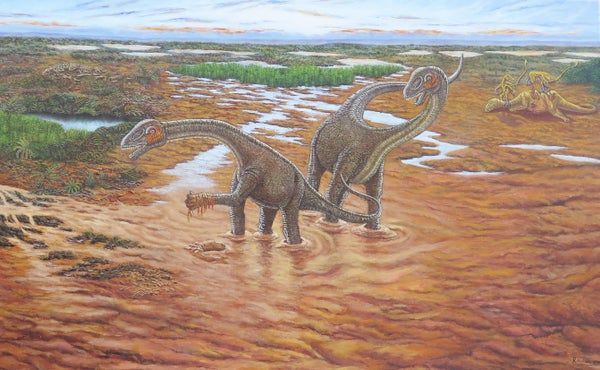This article was published in Scientific American’s former blog network and reflects the views of the author, not necessarily those of Scientific American
No dinosaur stands alone. Every time a new species is announced, that dinosaur is placed into the context of all that have come before. It's another evolutionary branch that helps us better understand the shape of the dinosaur family tree. And sometimes, when new dinosaurs emerge, they have unexpected connections.
Earlier this month paleontologist Rafael Royo-Torres and colleagues described a new sauropod dinosaur found in the roughly 135 million year old strata of eastern Utah. The jumble of bones recovered from the site includes most of the species' skeleton, including an articulated foot that hints this dinosaur might have wound up literally stuck in the mud. The researchers have named the dinosaur Mierasaurus bobyoungi. But what's surprising about this dinosaur, Royo-Torres and colleagues suggest, is that it has connections to sauropods that lived far away in space and time.
Mierasaurus is a turiasaur. I know that's not a household name, but stay with me for a second. Turiasaurs were a particular group of sauropod dinosaurs known only from the Late Jurassic rocks of Europe. Yet Mierasaurus - as well as the recently-named Moabosaurus - appear to be members of this group that lived in the Cretaceous of North America.
This surprise has some broad implications for how sauropods evolved and moved around the planet. Maybe there are other, older turiasaurs in North America that have gone unrecognized because no one thought they were on the continent. Or, as Royo-Torres and colleagues write, the Utah skeletons might document that this peculiar group of herbivores found a refuge in North America while going extinct in Europe. Either way, the dinosaurs had to wind up in North America somehow, and this will undoubtedly send experts back to museum collections and outcrops to track how a group that was thought to be strictly European wound up in Grand County, Utah. Chalk up another dinosaur and a whole bunch of questions.
Fossil Facts
On supporting science journalism
If you're enjoying this article, consider supporting our award-winning journalism by subscribing. By purchasing a subscription you are helping to ensure the future of impactful stories about the discoveries and ideas shaping our world today.
Name: Mierasaurus bobyoungi
Meaning: Mierasaurus is named for 18th century explorer Bernardo de Miera y Pacheco, "the first European scientist to enter what is now Utah." The species name bobyoungi is in honor of paleontologist Bob Young.
Age: Cretaceous, about 135 million years ago.
Where in the world?: Grand County, Utah.
What sort of organism?: A sauropod dinosaur.
How much of the organism’s is known?: A partial skeleton and referred isolated bones including a lower jaw and femur.
References:
Royo-Torres, R., Upchurch, P., Kirkland, J., DeBlieux, D., Foster, J., Cobos, A., Alcala, L. 2017. Descendants of the Jurassic turiasaurs from Iberia found refuge in the Early Cretaceous of western USA. Scientific Reports. doi: 10.1038/s41598-017-14677-2
Previous Paleo Profiles:
The Light-Footed Lizard The Maoming Cat Knight’s Egyptian Bat The La Luna Snake The Rio do Rasto Tooth Bob Weir's Otter Egypt's Canine Beast The Vastan Mine Tapir Pangu's Wing The Dawn Megamouth The Genga Lizard The Micro Lion The Mystery Titanosaur The Echo Hunter The Lo Hueco Titan The Three-Branched Cicada The Monster of Minden The Pig-Footed Bandicoot Hayden's Rattlesnake Demon The Evasive Ostrich Seer The Paradoxical Mega Shark The Tiny Beardogs The Armored Fish King North America's Pangolin The Invisible-Tusked Elephant The Mud Dragon The Spike-Toothed Salmon The Dream Coast Crocodile Buriol's Robber Ozimek's Flyer The Northern Naustoceratopsian The High Arctic Flyer The Tomatillo From the End of the World The Short-Faced Hyena The Mighty Traveler from Egg Mountain Keilhau's Ichthyosaur Mexico's Ancient Horned Face Mauricio Fernández's Plesiosaur New Zealand's Giant Dawn Penguin The Orange Sea Lion Mongolia's Ginkgo Cousin The Geni River Frog Isabel Berry's Dinosaur The Whale Caiman The Moab Lizard Yang Zhongjian's Lizard The Little Anubis The Shuangbai Lizard The Wyvern Dinosaur The "Need Helmet" Dinosaur The Jianianhua Dragon The Liaoning Hunter The Dalian Lizard Crompton's Aleodon Jenkins' Amphibian Serpent From the Chinle The Large Ancestor Lizard The Crown Tooth Currie's Alberta Hunter The Elephant Bird Mimic The Crested Thief The Hiding Hunter The Horned Lizard The Silk Bird The Sieve-Toothed Plesiosaur The Defenseless Snout Burian's Lizard The Small Whaitsiid The Beautiful Bird The Fierce Cat The Older One From Melksham The King of the Miocene Iberian Giraffes
